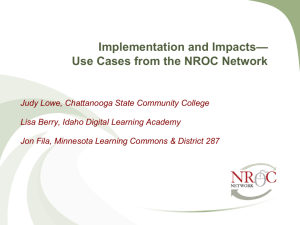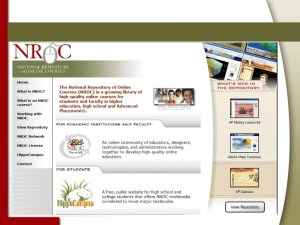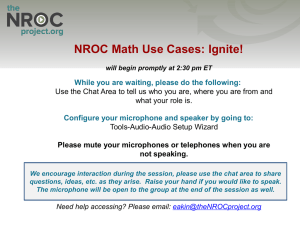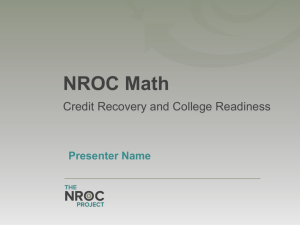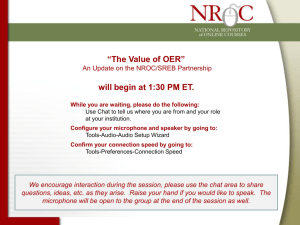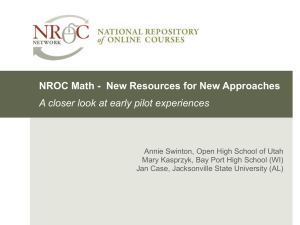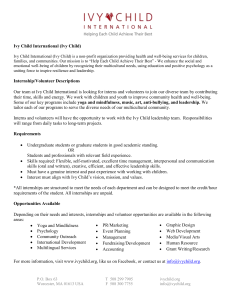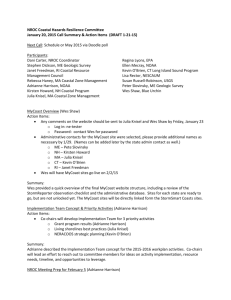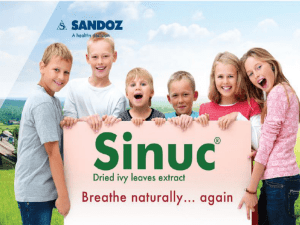Ivy Tech case study
advertisement
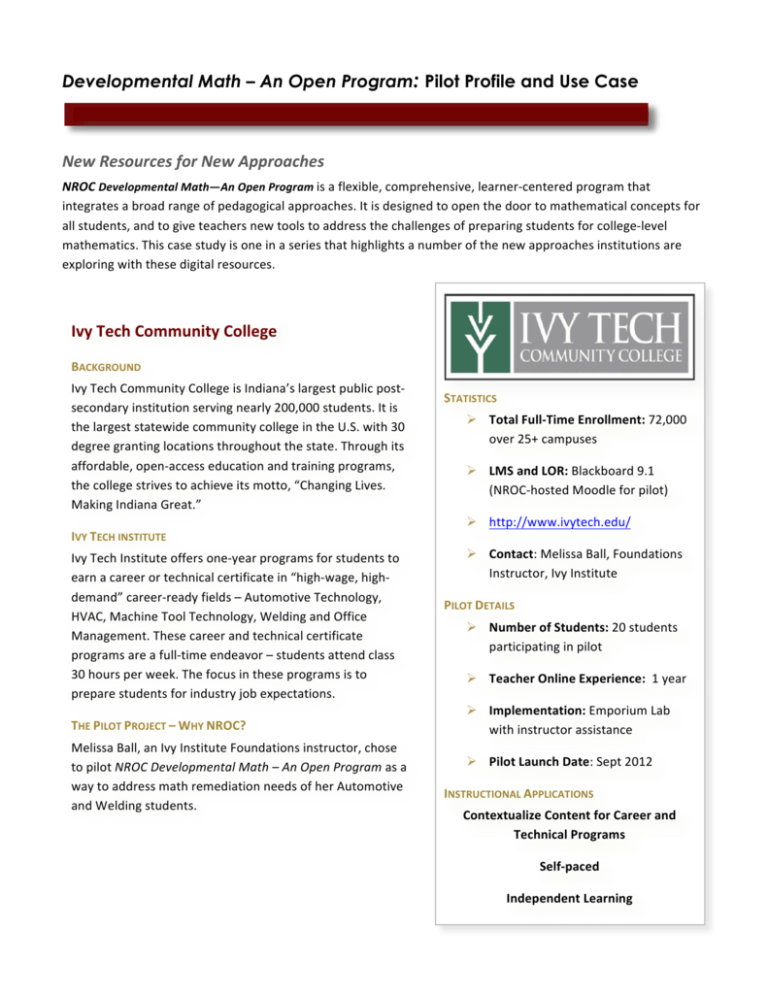
Developmental Math – An Open Program: Pilot Profile and Use Case New Resources for New Approaches NROC Developmental Math—An Open Program is a flexible, comprehensive, learner-­‐centered program that integrates a broad range of pedagogical approaches. It is designed to open the door to mathematical concepts for all students, and to give teachers new tools to address the challenges of preparing students for college-­‐level mathematics. This case study is one in a series that highlights a number of the new approaches institutions are exploring with these digital resources. Ivy Tech Community College BACKGROUND Ivy Tech Community College is Indiana’s largest public post-­‐ secondary institution serving nearly 200,000 students. It is the largest statewide community college in the U.S. with 30 degree granting locations throughout the state. Through its affordable, open-­‐access education and training programs, the college strives to achieve its motto, “Changing Lives. Making Indiana Great.” IVY TECH INSTITUTE Ivy Tech Institute offers one-­‐year programs for students to earn a career or technical certificate in “high-­‐wage, high-­‐ demand” career-­‐ready fields – Automotive Technology, HVAC, Machine Tool Technology, Welding and Office STATISTICS Ø Total Full-­‐Time Enrollment: 72,000 over 25+ campuses Ø LMS and LOR: Blackboard 9.1 (NROC-­‐hosted Moodle for pilot) Ø http://www.ivytech.edu/ Ø Contact: Melissa Ball, Foundations Instructor, Ivy Institute PILOT DETAILS Management. These career and technical certificate Ø Number of Students: 20 students participating in pilot 30 hours per week. The focus in these programs is to Ø Teacher Online Experience: 1 year programs are a full-­‐time endeavor – students attend class prepare students for industry job expectations. THE PILOT PROJECT – WHY NROC? Melissa Ball, an Ivy Institute Foundations instructor, chose to pilot NROC Developmental Math – An Open Program as a way to address math remediation needs of her Automotive and Welding students. Ø Implementation: Emporium Lab with instructor assistance Ø Pilot Launch Date: Sept 2012 INSTRUCTIONAL APPLICATIONS Contextualize Content for Career and Technical Programs Self-­‐paced Independent Learning To begin, each student takes a pre-­‐test to determine gaps in mastery. Based on the results, each students is assigned specific NROC units to work through at their own pace, while they are enrolled in welding or automotive classes. Students work independently in a computer lab for 90 minutes, Monday through Friday, with instructor assistance available. After 20 weeks of remediation, students are expected to be ready for the higher-­‐level math necessary to succeed in their chosen career. CONTEXTUALIZATION FOR CAREER PATHS The focus of Ivy Institute is to prepare students for the daily expectations of high-­‐wage, high-­‐demand industry jobs. Before students begin working through the NROC Developmental Math units, they are given specific examples of how they would use the math concepts in their career. When a student successfully completes an NROC unit (with a score above 80% on the unit quiz), they are presented with additional contextualized math problems. Examples of Math used in Welding • Fractions – measuring, blueprint reading, tolerances • Decimals – measuring, converting metric units, blueprint reading, tolerances, amount of gas usage • Ratios, Rate, Proportions – gas flow, wire speeds, weights of metals • Percentages – salary, bill of materials, estimating cost and time, gas usage • Measurement – tape measure, weld fillet gage, caliper, micrometer, bridge cam gauge • Geometry – weld length, blueprint reading, fabrication • Real Numbers – salary, operating cost • Solving Equations and Inequalities – comparing equipment, load strength, fabrication, gas formulas, cooling rates • Exponents and Polynomials – load strength, fabrication • Graphing – comparing metals, cost vs. revenue, weld testing EARLY RESULTS IVY TECH CONTEXTUALIZATION – WELDING MATH EXAMPLE 1.) What is the total length of weld for the work piece below? 1 ¾” 3 ½” 1 ¾” 3/8 18” Examples of Math used in Automotive • Fractions – tread wear, wheel stagger, toe-­‐rod sleeve to change toe-­‐in, throw of crankshaft related to stroke • Decimals – pistons, estimating time for serving, torque, costs, tire dimensions • Ratios, Rate, Proportions – engine compression, air to fuel ratios, alternator to engine drive ratio, tire pressure and volume • Percentages – efficiency of transmission, parts mark-­‐up, rear axle rotation • Measurement – part sizes, cylinder displacement, metric to English conversions, replacing a fan belt • Geometry – hose connections, revolution of tires, circumference of a fan pulley, capacity of fuel tank • Real Numbers – adjusting the caster angle, salary, operating costs • Solving Equations and Inequalities – force exerted on a piston, theoretic airflow of an engine • Graphing – cost vs. revenue IVY TECH CONTEXTUALIZATION – AUTOMOTIVE MATH EXAMPLE Tire pressure vs. Temperature The rule of thumb is for every 100F change in temperature the tire inflation will change 1 psi (up with higher temp and down with lower temp). At 700F cold tire pressure, (the tire is to be tested cold in the morning before driving) the recommended inflation is 20-­‐psi front and 33 psi rear. How much pressure change will occur if? Calculate for both front and rear tires. a. The temperature increased to 90 0F. b. The temperature decreased to 50 0F c. The tire pressure was correct sitting in a heated garage, but driven while the temperature was 0 0F. EARLY RESULTS Students have been responding positively to the NROC Developmental Math components. They like the fact that they can control the pace of their studies and review as needed. Melissa notices her students particularly like the Worked Examples, Presentations and Practice Problems. Early results show that students are achieving the math level they need for their career programs. At the conclusion of their course of study, students will take the Accuplacer exam. There is still a gap between students’ ability to learn the concepts and ability to do the math in context. math LESSONS LEARNED LESSONS LEARNED There is still a large gap between learning math concepts and mastering the procedures of math used in career contexts. To overcome this, Melissa plans to spend more time working through contextualized problems together with her students. She also plans to require students to take notes while they are watching the NROC topic-­‐level Presentations to better capture their understanding. WHAT’S NEXT? Melissa plans to adapt the Pre-­‐Assessment version of Developmental Math – An Open Program for an even a more personalized learning experience for students. ABOUT NROC NROC is a community-­‐guided, non-­‐profit project focused on new models of digital content development, distribution, and use. NROC is funded by The William and Flora Hewlett Foundation, the Bill & Melinda Gates Foundation, and most importantly by NROC members across the country. We are education leaders from state and system institutions nationwide who believe in open and equal access to education and the power of media to personalize learning. We represent more than 6 million U.S. students from middle school to college. Learn more: http://TheNROCProject.org. For additional information on Developmental Math – An Open Program, please visit http:// NROCmath.org, or email membership@theNROCproject.org.
